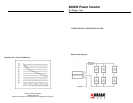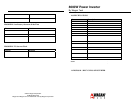
USER’S MANUAL — Please read before using this equipment.
© 2007 Wagan Corporation.
All Rights Reserved.
Wagan and Wagan.com are trademarks used by Wagan Corporation.
17
8000W Power Inverter
By Wagan Tech
an example of what is necessary to recharge a battery bank that has 16500 AH of
capacity (as in the example above) and has b een di scharged to 10.5 vol t s
(discharged). The charger has to replace 2145 AH (1650x 1.3 AH) in 14 hours. So
the charger must charge at a rate of 153 Amps for 14 hours. As this charge current
is distributed among the batteries in the battery bank, the current received by an
individual battery is within its charge rating. Be sure that the battery is well
vented as the area will likely have accumulations of an explosive mixture of
hydrogen and oxygen. Follow all recommendations for use that are contained in
the battery charger manual. If commercial automatic battery chargers do not have
the capacity to fully recharge the battery bank within the required time,
investigate using more than one au tomatic charger. Seek an expert to avoid
charging too quickly and risking overheating the batteries.
WARNING
THERE IS DANGER OF EXPLOSION. DO NOT CONNECT OR
DISCONNECT CHARGER CABLES DIRECTLY AFTE R BATTER Y
DISCHARGE OR RECHARGE –MAKE SURE THAT THE BATTERY BANK
AREA IS WELL VENTED BEFORE ATTACHING OR REMOVING CABLES.
If the flooded lead-acid batteries are used, as examples given in this document, be
sure to make periodic checks of battery electrolyte levels. Follow b a ttery
manufacturer’s instru ctions in keeping the electrolyte at the proper level. Be sure
to use pure distilled water when replacing evaporated electrolyte liquid.
7.3 Aboard A Vessel Or Vehicle
Manufacturer-supplied, engine-driven alternators can usually be replaced with
one that can continuously deliver higher amperage. This should be done at the
outset. Keep the batteries charging when the vessel or vehicle engine is operating.
In the case of a vessel, make sure that shore power is used to recharge the
batteries whenever possible.
8. OPERATING ISSUES TV AND AUDIO
Although all inverters are shield ed and filtered to minimize signal interference,
some interference with your television picture may be unavoidable, especially
with weak signals. However, here are some suggestions that may improve
www.wagan.com
18
reception.
• First, make sure that the television antenna produces a clear signal under
normal operating conditions (i.e., at home plugged into a standard
11O/120V AC wall outlet). Also, ensure that the antenna cable is
properly shielded and of good quality.
• Change the positions of the antenna cables and television power cord.
• Isolate the television, its power cord and antenna cables from the inerter
by running an extension cord from the inverter to the television set.
• Coil the television power cord or install a clamp-on ferrite choke
(available from electronic parts suppliers).
Note: Some inexpensive audio systems may have a slight "buzzing" sound when
operated with the inverter. This is caused by insufficient filtering in the audio
system. The only solution to this problem is to get a sound system with a higher
quality power supply.
9. TROUBLESHOOTING
PROBLEM: No Output Voltage
Reason Solution
Poor contact with battery
terminals.
Shut down inverter an d
disconnect. Clean terminals
thoroughly and reconnect
Blown DC battery fuse(s). Turn off inverter. Replace
fuse(s) with same type and rating
PROBLEM: Inverter is Shut Down
Reason Solution
Battery voltage below 10
Volts
Recharge or replace battery.
Inverter is too hot (thermal
shut down mode).
Allow inverter to cool.
Check for adequate v entilation.
Reduce the load on the inverter













